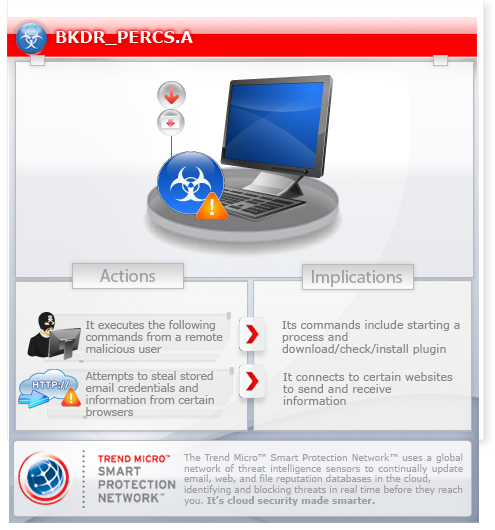BKDR_PERCS.A
Windows 2000, Windows Server 2003, Windows XP (32-bit, 64-bit), Windows Vista (32-bit, 64-bit), Windows 7 (32-bit, 64-bit)


Threat Type: Backdoor
Destructiveness: No
Encrypted: Yes
In the wild: Yes
OVERVIEW
This malware is related to an attack that took advantage of legitimate services like Google Drive and Dropbox in order to look less suspicious to unwary users.
To get a one-glance comprehensive view of the behavior of this Backdoor, refer to the Threat Diagram shown below.

This backdoor may be unknowingly downloaded by a user while visiting malicious websites.
It executes commands from a remote malicious user, effectively compromising the affected system. It connects to a website to send and receive information.
It logs a user's keystrokes to steal information.
TECHNICAL DETAILS
Arrival Details
This backdoor may be unknowingly downloaded by a user while visiting malicious websites.
Installation
This backdoor drops the following copies of itself into the affected system:
- %Application Data%\scvperc.exe
(Note: %Application Data% is the current user's Application Data folder, which is usually C:\Documents and Settings\{user name}\Application Data on Windows 2000, XP, and Server 2003, or C:\Users\{user name}\AppData\Roaming on Windows Vista and 7.)
Autostart Technique
This backdoor adds the following registry entries to enable its automatic execution at every system startup:
HKEY_CURRENT_USER\Software\Microsoft\
Windows\CurrentVersion\Run
scvperc = "%Application Data%\scvperc.exe"
Backdoor Routine
This backdoor executes the following commands from a remote malicious user:
- Download and execute arbitrary file in %User Temp%
- Remote command prompt
- Get drive information
(Note: %User Temp% is the current user's Temp folder, which is usually C:\Documents and Settings\{user name}\Local Settings\Temp on Windows 2000, XP, and Server 2003, or C:\Users\{user name}\AppData\Local\Temp on Windows Vista and 7.)
It connects to the following websites to send and receive information:
- {BLOCKED}i.{BLOCKED}2.com:32040
Dropping Routine
This backdoor drops the following file(s), which it uses for its keylogging routine:
- %Application Data%\Logs\{date-month-year} - encrypted
(Note: %Application Data% is the current user's Application Data folder, which is usually C:\Documents and Settings\{user name}\Application Data on Windows 2000, XP, and Server 2003, or C:\Users\{user name}\AppData\Roaming on Windows Vista and 7.)
Information Theft
This backdoor attempts to steal stored email credentials from the following:
- Windows Live
- Mozilla Thunderbird
- Outlook
It attempts to get stored information such as user names, passwords, and hostnames from the following browsers:
- Mozilla Firefox
- Opera
- Internet Explorer
- Google Chrome
- Chromium
It logs a user's keystrokes to steal information.
SOLUTION
Step 1
Before doing any scans, Windows XP, Windows Vista, and Windows 7 users must disable System Restore to allow full scanning of their computers.
Step 2
Note that not all files, folders, and registry keys and entries are installed on your computer during this malware's/spyware's/grayware's execution. This may be due to incomplete installation or other operating system conditions. If you do not find the same files/folders/registry information, please proceed to the next step.
Step 3
Restart in Safe Mode
Step 4
Delete this registry value
Important: Editing the Windows Registry incorrectly can lead to irreversible system malfunction. Please do this step only if you know how or you can ask assistance from your system administrator. Else, check this Microsoft article first before modifying your computer's registry.
- In HKEY_CURRENT_USER\Software\Microsoft\Windows\CurrentVersion\Run
- scvperc = "%Application Data%\scvperc.exe"
- scvperc = "%Application Data%\scvperc.exe"
Step 5
Search and delete this file
- %Application Data%\Logs\{day-month-year}
Step 6
Restart in normal mode and scan your computer with your Trend Micro product for files detected as BKDR_PERCS.A. If the detected files have already been cleaned, deleted, or quarantined by your Trend Micro product, no further step is required. You may opt to simply delete the quarantined files. Please check this Knowledge Base page for more information.
Did this description help? Tell us how we did.

